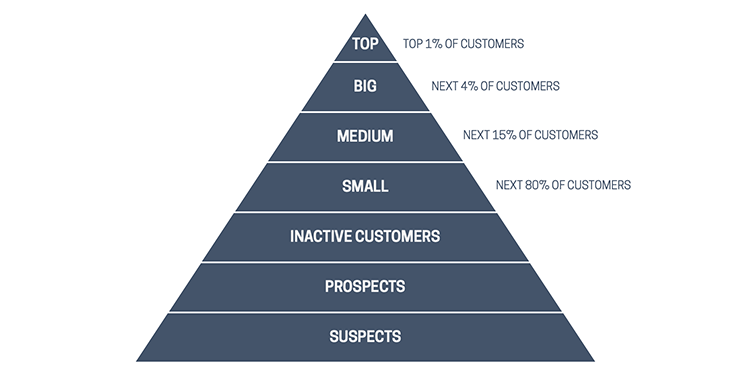Curry's Client Pyramid
Curry's Client Pyramid provides a way to classify customers by value, allowing a company to assign appropriately targeted sales and marketing resources to each segment.

What it is
Curry's Client Pyramid is a tool designed to help businesses identify and classify their customers by their value to the business. This classification can enable businesses to apply different marketing and sales strategies for each segment rather than adopt a blanket approach which may be less efficient.

The pyramid is based on the Pareto Principle, also known as the 80-20 rule. This proposes that 80% of a company's revenue is generated by 20% of its clients. The key takeaway is that not all customers generate the same revenue and profit, and it is to a company's advantage to identify their most valuable customers.
Background
The Client Pyramid was first proposed by Jay and Adam Curry in their 2000 book, "The Customer Marketing Method", following their research into customer relationship management.
When to use it
- To assess the current client base in terms of value to the company
- When striving for efficiency gains in marketing
- When deciding how much relationship management effort should be spent with different customers and potential customers
How to use it
The first step is to determine which customers and groups of potential customers fit within each level of the pyramid.
The top three levels - top, big and medium - account for the top 20% of customers (and 80% of the company revenue if Pareto's Principle applies).
The remaining levels are:
- Small customers - the remaining 80% of current customers
- Inactive customers - customers who have bought from the company in the past but are not currently generating revenue
- Prospects - e.g. potential customers who have received a proposal or quote from the company
- Suspects - e.g. potential customers who have expressed an interest but have not taken any further action
Once this work is complete, strategies can be developed which are specifically targeted at each level. With the exception of the Top clients, the main aim of the strategy within each level must be to move clients up to the next stage. For the top 1% of customers, the strategy will focus on retention and growth.
Frequently asked questions (FAQs)
Does Curry's Client Pyramid only apply to existing customers?
Rather than focussing only on existing customers, segmenting potential customers using this model is also a worthwhile exercise. This can be beneficial when developing customer acquisition strategies. One of the criticisms of Curry's Client Pyramid model is that it encourages marketers to focus all their efforts on growing existing clients, at the expense of finding new ones.
Should clients only be segmented by revenue generation?
Curry's Client Pyramid was originally intended to be used to classify customers based on the revenue they bring to the company. However, many companies have successfully applied this model over the last two decades using alternative metrics such as profit, company size, money spent with competitors, or total addressable spend.
Further reading
Curry, J. and Curry, A. (2000) The Customer Marketing Method: How to implement and profit from customer relationship management. New York: Simon and Schuster.
Some of the links to products provided in this article are affiliate links. This means that the supplier may pay the owner of this website a small amount of money for purchases made via the link. This will have absolutely no impact on the amount you pay.

